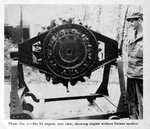Hello gentlemen,
I'm looking for every possible information regarding the few 11/22 cylinder radial engines ever produced. High quality pictures or drawings would be appreciated.
Engines that I know of:
WW1 period
Clerget 11 - Rare 11 cyl. rotary engine. At least one preserved specimen in museum
Siemens Halske SH.III - 11 cyl. rotary engine with counter rotating crankshaft. Several specimens surviving. Great deal of material and info available
WW2 period
Wright R-4090 - Prototype. 22 cyl. Only images scanned from books available
Mitsubishi Ha-50 - 22 cyl. A complete, but damaged, specimen is displayed at the Narita airport. High quality pics would be welcome
Hitachi Ha-51 - Prototype. 22 cyl. Only images scanned from books available
Did I miss anything? Thanks!
I'm looking for every possible information regarding the few 11/22 cylinder radial engines ever produced. High quality pictures or drawings would be appreciated.
Engines that I know of:
WW1 period
Clerget 11 - Rare 11 cyl. rotary engine. At least one preserved specimen in museum
Siemens Halske SH.III - 11 cyl. rotary engine with counter rotating crankshaft. Several specimens surviving. Great deal of material and info available
WW2 period
Wright R-4090 - Prototype. 22 cyl. Only images scanned from books available
Mitsubishi Ha-50 - 22 cyl. A complete, but damaged, specimen is displayed at the Narita airport. High quality pics would be welcome
Hitachi Ha-51 - Prototype. 22 cyl. Only images scanned from books available
Did I miss anything? Thanks!



